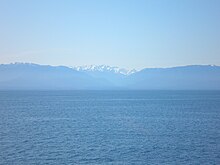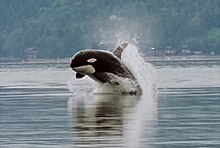Salish Sea
| Salish Sea | |
|---|---|
The Salish Sea (
The sea stretches from the channels of the Discovery Islands north of the Strait of Georgia to Budd Inlet at the south end of Puget Sound. It is partially separated from the open Pacific Ocean by Vancouver Island and the Olympic Peninsula.
Much of the coast is part of the
Name
Etymology
The first known use of the term "Salish Sea" was in 1988 when Bert Webber, a geography and environmental social studies professor emeritus in Huxley College of the Environment at Western Washington University in Bellingham, Washington, created the name for the combined waters in the region with the intention to complement the names Georgia Strait, Puget Sound, and Strait of Juan de Fuca, not replace them.[8] The adoption of the term, he said, would raise consciousness about taking care of the region's waters and ecosystems. Webber's efforts are credited with the official recognition of the term in Canada and the U.S.
Coast Salish peoples

The
The waterways of the Salish Sea were important trade routes for the Coast Salish, and they remain a source of food and other resources for the
Official recognition
In March 2008, the
In August 2009, the British Columbia Geographical Names Office approved a resolution recommending that the
In a 2019 survey of residents in the general vicinity of the Salish Sea, only 9% of Washingtonians and 15% of British Columbians were able to correctly identify and name the Salish Sea.[22]
Other names
The region encompassing these waterways is or was also known variously as the Georgia–Puget or Puget–Georgia Basin, or in the singular as the
Geography


The Salish Sea is about 440 km (270 mi) long and has a surface area of about 18,000 km2 (6,900 sq mi), which is roughly the same size as the Gulf of Riga in Northern Europe.[3] This combines the total surface area of the Strait of Georgia (6,400 km2 or 2,471 mi2), Strait of Juan de Fuca (4,400 km2 or 1,699 mi2), Puget Sound (2,500 km2 or 965 mi2), Desolation Sound (1,100 km2 or 425 mi2), and various other bodies of water (3,600 km2 or 1,390 mi2).[2][24] The sea has an average depth of 130 m (430 ft) and reaches a maximum depth of 670 m (2,200 ft) in Jervis Inlet.[4]
Extent
The Transboundary Georgia Basin–Puget Sound Environmental Indicators Working Group defines the limits of the Salish Sea as:[2][3][25]
On the West. The entrance to Juan de Fuca Strait (a line between Cape Flattery and Carmanah Point).
On the South. The south end of Puget Sound (the head of Budd Inlet).
On the North. Extends just beyond the Strait of Georgia to include those channels and waterways where the floodstream or tidal surge is from the south: Discovery Passage south of Seymour Narrows, Sutil Channel south of Penn Islands, Lewis Channel, Waddington Channel and Pendrell Sound, Desolation Sound, and the southern portion of Homfray Channel.
Hydrology
The watershed of the Salish Sea (not including the Upper Fraser River watershed) has a total area of about 110,000 km2 (42,000 sq mi), which is over six times the surface area of the sea itself.[2] Major rivers discharging into the sea include the Fraser River, Nisqually River, Nooksack River, Puyallup River, Skagit River, Snohomish River, and Squamish River.
The flow of fresh water into the Salish Sea from numerous rivers and the introduction of salt from the Strait of Juan de Fuca create a
Residence times at intermediate depths average 60 days in Puget Sound and 160 days in the Strait of Georgia.[5][28]
Islands

The Salish Sea contains more than 400 islands, most of which can be grouped into one of three island groups: the Discovery Islands, Gulf Islands, and San Juan Islands.
Whidbey Island in Washington is the largest and most populous island with a total area of 436.9 km2 (168.7 sq mi) and an estimated population of 69,480 as of 2010.[29][30] Bainbridge Island, also in Washington, is the most densely populated island with 354 residents/km2 (916 residents/mi2) as of 2019.[31] The largest island by far on the Canadian side is Texada Island of 300.45 km2 (116.00 sq mi), but a population of 1000–2000 people.
Geology
The Salish Sea sits within the
Ecology
Marine
The Salish Sea supports an active and dynamic marine ecosystem, dominated by species suited to the
Flora

The Salish Sea hosts a diverse community of
Eelgrass meadows are abundant throughout the shallower regions of the sea.[34]
Fauna

The Salish Sea is home to
In addition, the sea hosts 37 marine mammal species, most notably
Sea otters have been increasingly observed within the Strait of Juan de Fuca.[41]
Sponge reefs
The mineral-rich waters of the Salish Sea are an ideal habitat for the formation of
Terrestrial
The lowlands surrounding the Salish Sea are part of the WWF-designated Puget lowland forests and Central Pacific coastal forests ecoregions.
Of the 172 bird species found in the area, 72 are highly dependent on the marine ecosystem for their food.[44]
History
This section may contain information not important or relevant to the article's subject. (July 2022) |
Since August 20, 2007, at least 20 detached human feet have been found on the coasts of the Salish Sea.[45] The first discovery, on August 20, 2007, was on Jedediah Island in British Columbia.[46]
See also
References
- ^ Government of Canada, Natural Resources Canada. "Place names – Mer des Salish". www4.nrcan.gc.ca. Retrieved November 18, 2021.
- ^ a b c d e Environmental History and Features of Puget Sound Archived May 13, 2009, at the Wayback Machine, NOAA-NWFSC
- ^ a b c d "BC Geographical Names – Salish Sea". apps.gov.bc.ca. Retrieved September 29, 2020.
- ^ a b Government of Canada, Fisheries and Oceans (January 29, 2009). "Fisheries and Oceans Canada |Pacific Region | Jervis Inlet". www.pac.dfo-mpo.gc.ca. Retrieved October 3, 2020.
- ^ a b "Puget Sound's physical environment | Encyclopedia of Puget Sound". www.eopugetsound.org. Retrieved October 1, 2020.
- S2CID 129018974.
- ^ Canada, Environment and Climate Change (February 12, 2021). "Importance Salish Sea". www.canada.ca. Retrieved July 30, 2023.
- ^ Stefan Freelan (Washington State University) 2009: "The Salish Sea (& surrounding basin"): "Rather than being a replacement for any of the existing names, the designation 'Salish Sea' is an overlay, which includes and unites the established and familiar names of the various water and land bodies".
- ISBN 978-3-11-015492-4.
- ^ OCLC 1297754.
- ^ Oxford English Dictionary. Salish. Second Edition 1989 (online). Retrieved November 23, 2009.
- ^ "Salish". Encyclopædia Britannica, Inc. Retrieved November 23, 2009.
- ^ "Tribal Preservation Department". Confederated Salish & Kootenai Tribes. Archived from the original on March 15, 2012. Retrieved November 23, 2009.
- ^ "Salish Culture Committee". Confederated Salish & Kootenai Tribes. Archived from the original on April 21, 2012. Retrieved November 23, 2009.
- ^ "Flathead Lake". Geographic Names Information System. United States Geological Survey, United States Department of the Interior.
- ISBN 978-0-7426-9809-3.
- ^ "Strait of Georgia could be renamed Salish Sea". Canadian Press. CBC.ca. March 9, 2008. Retrieved March 10, 2008.
- ^ "Washington state adopts "Salish Sea" name for body of water including Strait of Georgia". The Georgia Straight. October 30, 2009.
- ^ Berger, Knute (October 20, 2009). "Smooth Sailing for the Salish Sea?". Crosscut Blog. Archived from the original on January 5, 2010. Retrieved June 1, 2020.
- ^ "State Board on Geographic Names Approves 'salish Sea'". October 30, 2009. Archived from the original on October 30, 2013.
- ^ Berger, Knute (November 12, 2009). "U.S. approves Salish Sea name". Crosscut.com. Archived from the original on February 27, 2010. Retrieved August 13, 2011.
- ^ Trimbach, David; Gaydos, Joe (May 20, 2019). "Survey illustrates a lack of familiarity with the Salish Sea". Puget Sound Institute. Retrieved May 21, 2019.
- ISBN 978-1-4120-7097-3.
- ^ "Map of the Salish Sea & Surrounding Basin – Maps by Stefan Freelan". Retrieved October 9, 2020.
- ^ "GNIS Detail – Salish Sea". geonames.usgs.gov. Retrieved September 29, 2020.
- ^ "A year of LiveOcean salinity fields". faculty.washington.edu. Retrieved October 3, 2020.
- ^ Cannings, Richard and Sidney. British Columbia: A Natural History. p. 41. Greystone Books. Vancouver. 1996
- S2CID 129018974.
- ^ "Search Results". The United States Census Bureau. Retrieved September 29, 2020.
- ^ "Community Facts: Camano CDP, Washington". United States Census Bureau. Retrieved September 26, 2019.[permanent dead link]
- ^ "Annual Estimates of the Resident Population for Incorporated Places in Washington: April 1, 2010 to July 1, 2019". United States Census Bureau. May 2020. Retrieved May 27, 2020.
- ^ "About the Strait • Georgia Strait Alliance". Georgia Strait Alliance. Retrieved October 9, 2020.
- ^ Parks Canada Agency, Government of Canada (March 22, 2018). "Environment – Gulf Islands National Park Reserve". www.pc.gc.ca. Retrieved August 24, 2020.
- ^ a b "Puget Sound Kelp Conservation and Recovery Plan May 2020" (PDF). Northwest Straits Commission. May 1, 2020. Archived (PDF) from the original on September 24, 2020. Retrieved September 26, 2020.
- ^ Pietsch, Theodore W.; Orr, James W. (September 2015). NOAA Professional Paper NMFS 18-Fishes of the Salish Sea: a compilation and distributional analysis (PDF) (Report). National Marine Fisheries Service. p. 1. Archived from the original (PDF) on June 14, 2017. Retrieved November 15, 2015.
- ISSN 2397-334X.
- PMID 28662095.
- ^ Lynda V. Mapes (January 3, 2019). "2 more Puget Sound orcas predicted to die in critically endangered population". Seattle Times. Retrieved January 5, 2019.
- ^ Robinson, M. (August 7, 2019). "Deaths of southern resident killer whales raise fears for population". Vancouver Sun. Retrieved August 9, 2019.
- ^ "Record number of humpback calves spotted in Salish Sea and 'surprised' researchers wonder why | Globalnews.ca". Global News. Retrieved October 23, 2021.
- ^ Ollikainen, Rob (July 22, 2018). "Sea otter sightings swell in Strait of Juan de Fuca". Peninsula Daily News. Retrieved September 28, 2020.
- ^ Government of Canada, Fisheries and Oceans Canada (September 18, 2019). "Hecate Strait/Queen Charlotte Sound Glass Sponge Reefs Marine Protected Area (HS/QCS MPA)". www.dfo-mpo.gc.ca. Retrieved September 26, 2020.
- ^ Government of Canada, Fisheries and Oceans Canada (August 30, 2019). "Strait of Georgia and Howe Sound Glass Sponge Reef (17 fisheries area closures)". www.dfo-mpo.gc.ca. Retrieved September 27, 2020.
- S2CID 84847690.
- ^ Fraga, Kaleena (May 20, 2023). "The Eerie Mystery Behind The 21 Severed Feet That Have Washed Ashore In The Pacific". All That's Interesting. Retrieved March 4, 2024.
- ^ "Discovery of unattached human feet baffles B.C. police". CBC News. August 31, 2007. Retrieved June 18, 2008.
Further reading
External links
- Gaydos, Joseph K.; Dierauf, Leslie; Kirby, Grant; Brosnan, Deborah; Gilardi, Kirsten; Davis, Gary E. (December 2008). "Top 10 Principles for Designing Healthy Coastal Ecosystems Like the Salish Sea" (PDF). EcoHealth. 5 (4): 460–471. S2CID 11325705. Retrieved November 3, 2022.
- Gaydos, Joseph K.; Dierauf, Leslie; Kirby, Grant; Brosnan, Deborah; Gilardi, Kirsten; Davis, Gary E. (December 2008). "Top 10 Principles for Designing Healthy Coastal Ecosystems Like the Salish Sea" (PDF). EcoHealth. 5 (4): 460–471.
